8.10.2021
Galileo satellites arrive at Europe’s Spaceport
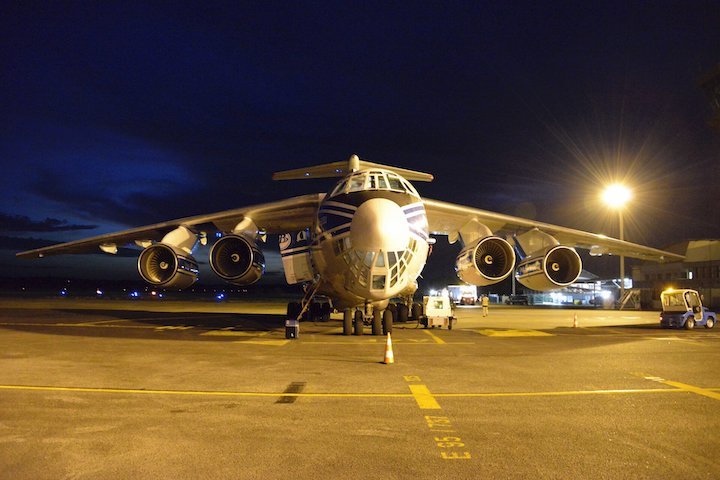
The latest pair of Galileo satellites have touched down at Europe’s Spaceport in French Guiana, ahead of their launch together next month.
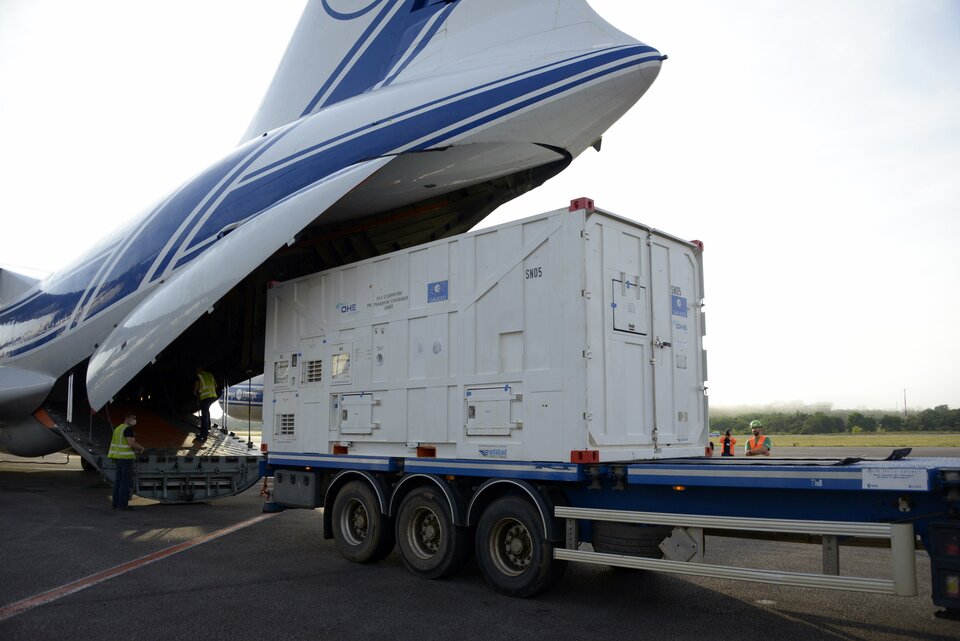
Cocooned safely within environmentally controlled containers, the satellites were carried across the Atlantic aboard an Ilyushin cargo carrier. The satellites left ESA’s ESTEC Test Centre in Noordwijk, the Netherlands, on Tuesday morning heading for Liège Airport in Belgium. From here they flew to Cayenne in French Guiana via a stop in Oporto Airport in Portugal, arriving at their final destination on Wednesday evening local time.
Once unloaded from the aircraft, the satellites were then driven through the tropical dusk to the cleanroom surroundings of the spaceport nearby Kourou, where they could be safely unpacked to begin the satellite launch campaign.

These two satellites are the first of the last batch of Galileo First Generation satellites, known as ‘Batch 3’, made up of 12 satellites in all. They are built by OHB SE in Bremen, Germany, with their navigation and search and rescue payloads contributed by Surrey Satellite Technology Ltd in Guildford in the UK.
Before being cleared for launch, the satellites have gone through rigorous testing at ESA’s ESTEC Test Centre, the largest satellite test facility in Europe – their last stop before flying to South America.
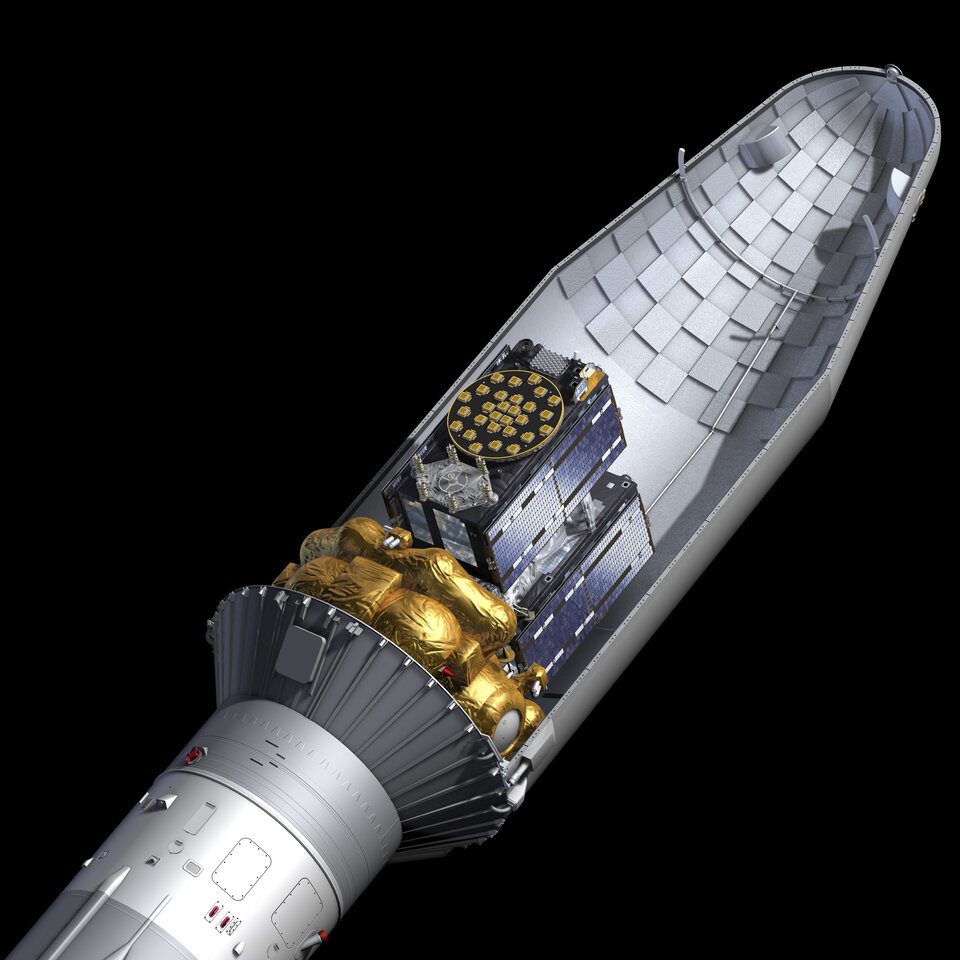
These two satellites will be launched together aboard a Soyuz launcher from Europe’s Spaceport in French Guiana. The launcher incorporates a Fregat upper stage, which will carry them to their planned 23 222 km altitude medium-Earth orbit.
These satellites will add to the 26-satellite Galileo constellation already in orbit and delivering Initial Services around the globe.
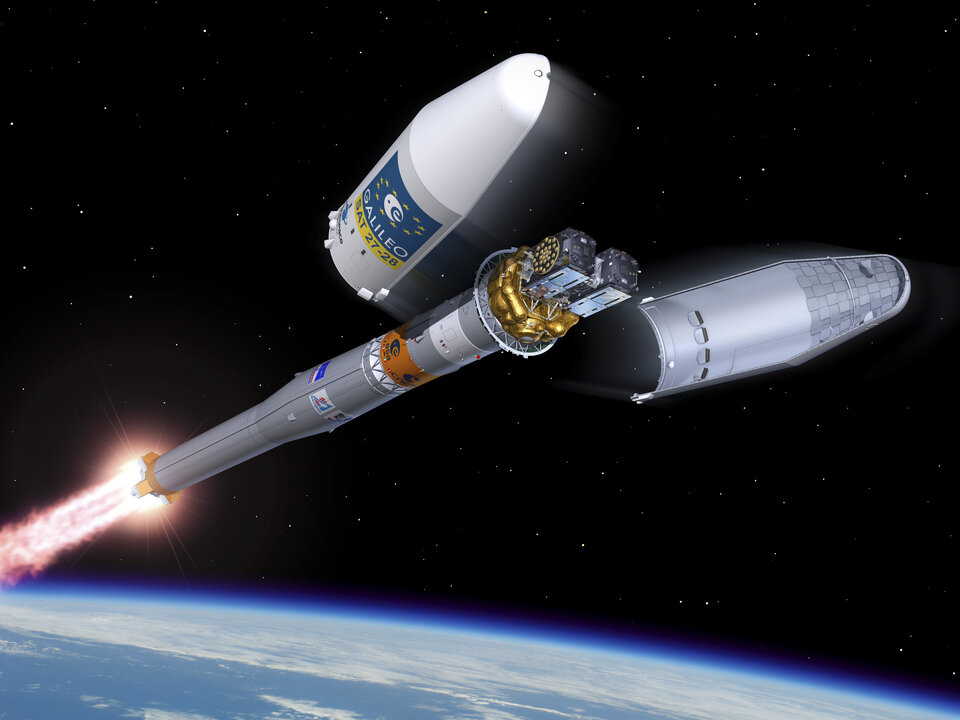
Next month’s lift-off will be the 11th Galileo launch in 10 years. Two further launches are planned for next year, to allow Galileo to reach Full Operational Capability in its delivery of services, to be followed by the launches of the rest of the Batch 3 satellites which are currently all undergoing pre-flight testing.
In parallel to Batch 3’s completion of Galileo First Generation deployment, the new Galileo Second Generationsatellites, featuring enhanced navigation signals and capabilities, are already in development with their deployment expected to begin by 2024.
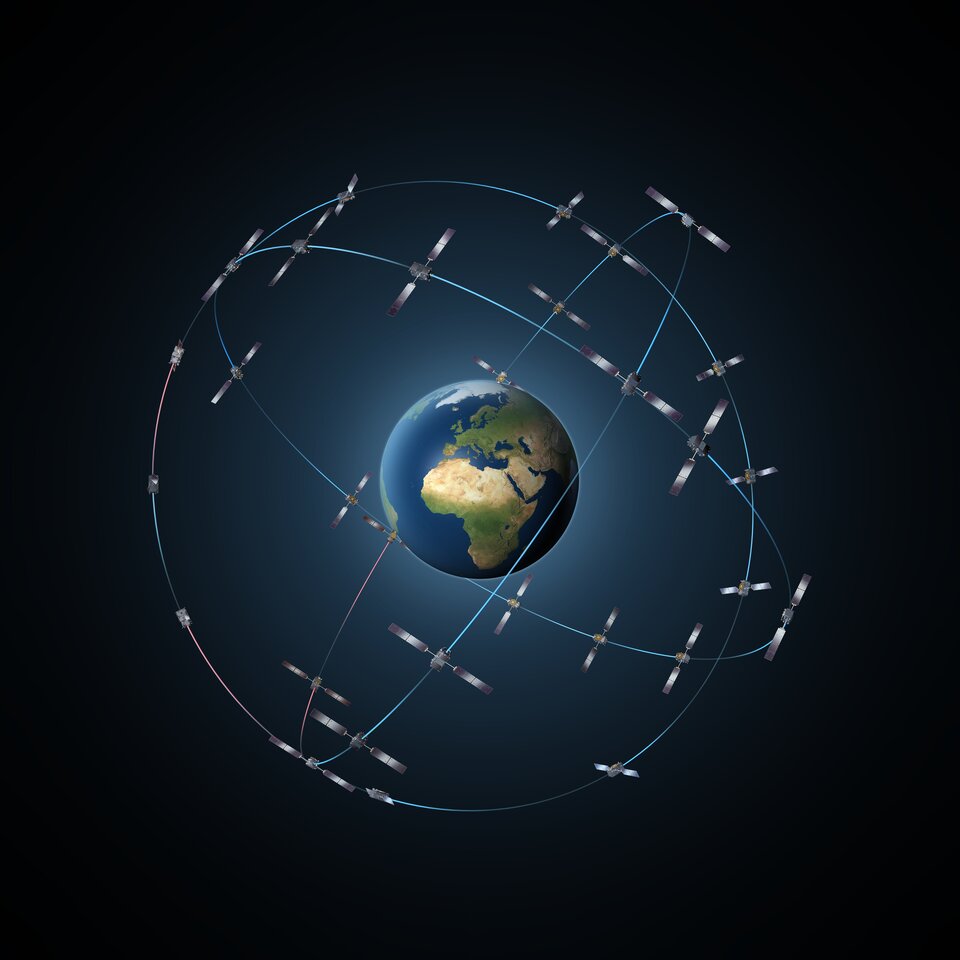
About Galileo
Galileo is currently the world’s most precise satellite navigation system, serving more than two billion users around the globe.
The Full Operational Capability phase of the Galileo programme is managed and funded by the European Union. The European Commission, ESA and EUSPA (the EU Agency for the Space Programme) have signed an agreement by which ESA acts as design authority and system development prime on behalf of the Commission and EUSPA as the exploitation and operation manager of Galileo/EGNOS. “Galileo” is registered as a trademark in the database of the European Union Intellectual Property Office (n° 002742237).
Quelle: ESA
----
Update: 26.11.2021
.
Galileo satellites in place for launch
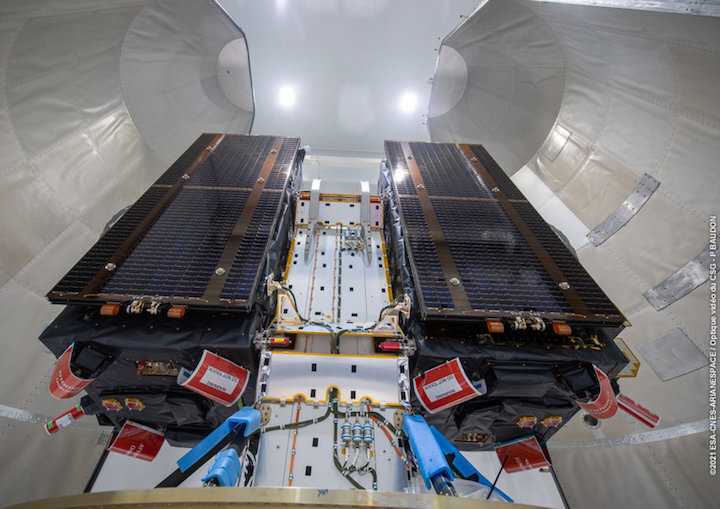
Europe’s next two Galileo satellites have been attached to the dispenser on which they will ride to orbit, and the launcher fairing that will protect them during the first part of the ascent to orbit has been closed around the pair.

Galileo satellites 27 – 28 are scheduled to be launched by Soyuz launcher from Europe’s Spaceport in French Guiana on 2 December at 01:31 CET (1 December at 21:31:27 local Kourou time).
Their dispenser has the double duty of securing the two satellites safely in place during the lift off and flight, then deploying the satellites into their target orbit.
The combined satellites plus dispenser were then placed onto their Soyuz Fregat upper stage, which has the job of hauling the pair most of the way up to medium Earth-orbit, before being enclosed in their launch fairing.
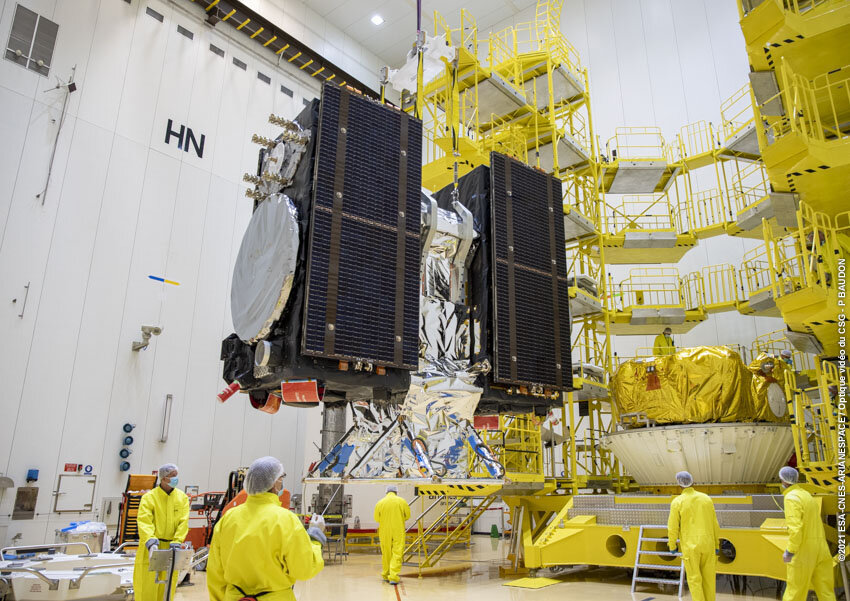
The next step will see this combined ‘upper composite’ being taken to the launch site for integration with the other three stages of their Soyuz launcher, after the launcher is installed on the launch pad.
Bastiaan Willemse, ESA Galileo Full Operational Capability Satellites Manager comments from Europe’s spaceport in Kourou, French Guiana: “So far, everything has been going according to plan and we are heading towards the ending of a smooth launch campaign, which started in early October.”
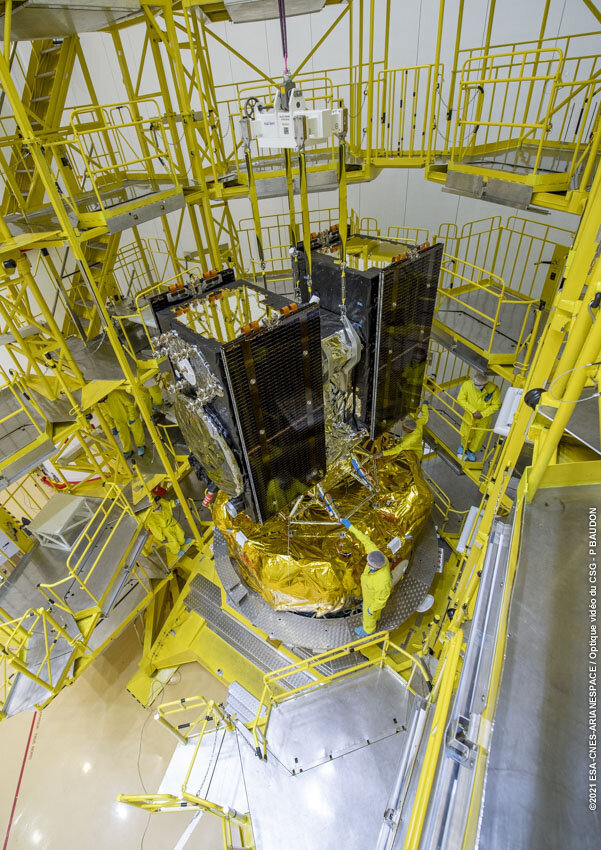
These first of a total of 12, Galileo ‘Batch-3’ satellites, manufactured by OHB Systems and their suppliers from all across Europe.
The pair arrived from ESA’s ESTEC Test Centre to the integration facility in French Guiana in early October, kicking off a busy launch campaign, including initial dispenser ‘fit checks’, filling with the hydrazine fuel that will be used to manoeuvre them during their 12 years of working life and finalisation of their navigation system generation units and uploading of security keys.
These satellites will add to the 26-satellite Galileo constellation already in orbit and delivering Initial Services around the globe.
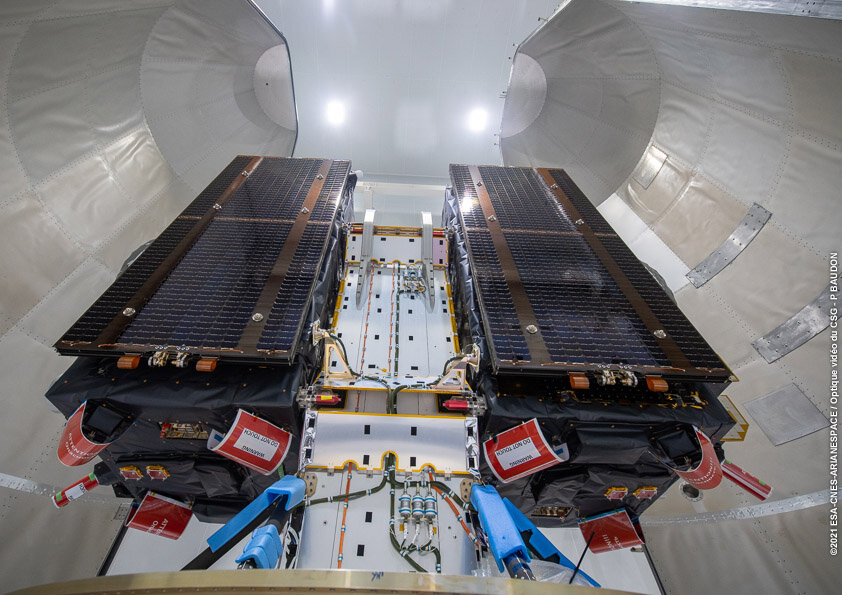
Next week’s lift-off will be the 11th Galileo launch in 10 years. Two further launches are planned for next year, to allow Galileo to reach Full Operational Capability in its delivery of services, to be followed by the launches of the rest of the Batch 3 satellites which are currently all undergoing pre-flight testing.
In parallel to Batch-3’s completion of Galileo First Generation deployment, the new Galileo Second Generation satellites, featuring enhanced navigation signals and capabilities, are already in development with their deployment expected to begin by the end of 2024.
About Galileo

Galileo is currently the world’s most precise satellite navigation system, serving more than two billion users around the globe.
The Galileo programme is managed and funded by the European Union. The European Commission, ESA and EUSPA (the EU Agency for the Space Programme) have signed an agreement by which ESA acts as design authority and system development prime on behalf of the Commission and EUSPA as the exploitation and operation manager of Galileo/EGNOS. “Galileo” is registered as a trademark in the database of the European Union Intellectual Property Office (n° 002742237).

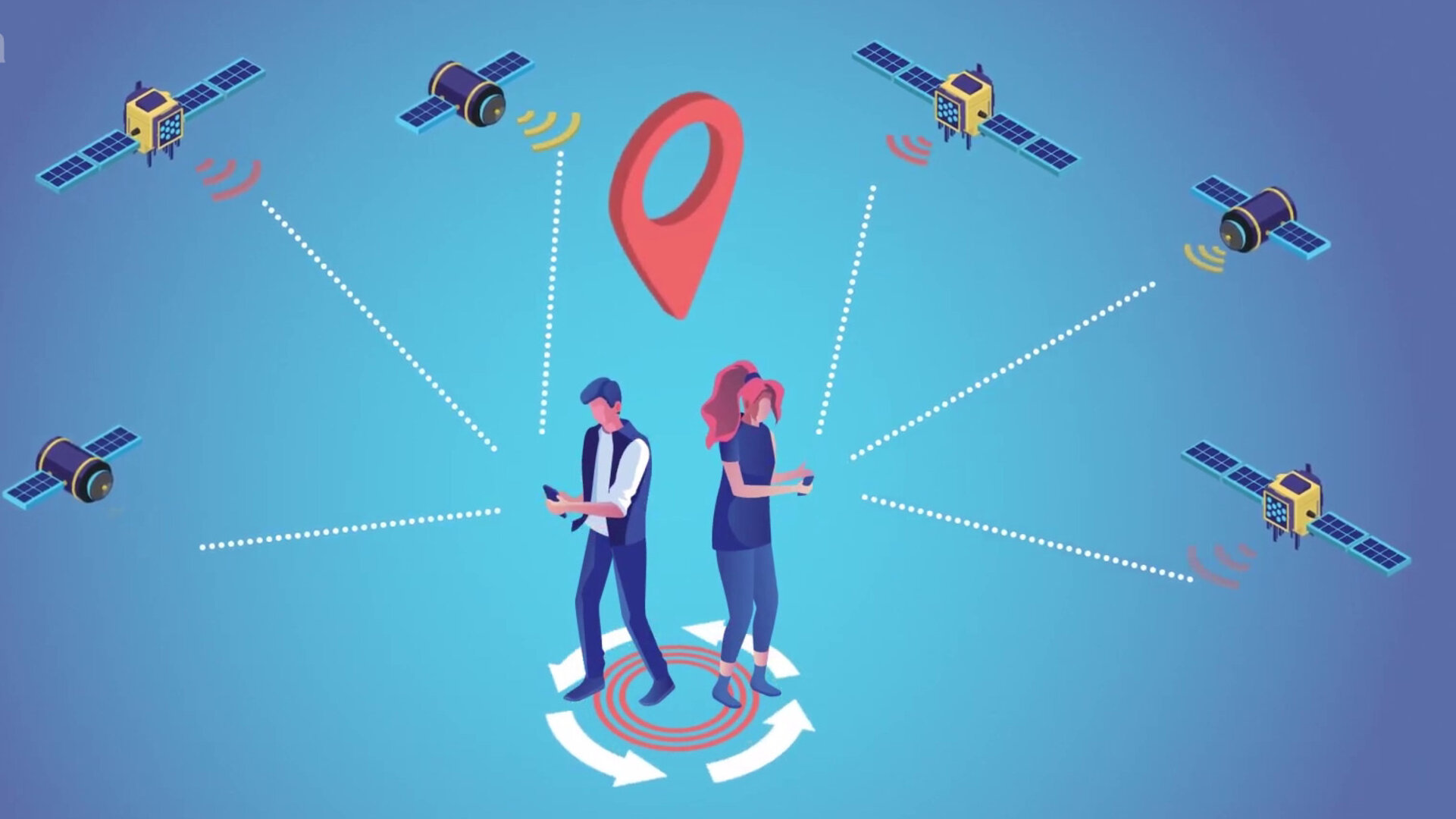
Access the video
VS26 mission: Arianespace at the service of European satellite navigation with Galileo

- For its 13th launch of the year, Arianespace will orbit two more satellites, Galileo FOC 23 and 24, bringing the Galileo constellation fleet to 28 satellites. This mission will be performed for the benefit of the European Space Agency (ESA) acting on behalf of the European Commission.
– VS26 will be the 150th mission launched by Arianespace for European institutions, the 46th mission of Soyuz at the service of institutional needs. This flight will also mark 10 years of Soyuz operations in French Guiana.
– These two new satellites, Galileo FOC 23 and Galileo FOC 24, will join the 26 satellites already in orbit among Europe’s own global navigation satellite system, providing the world’s most precise positioning service. They will be operated under the responsibility of the European Union Agency for the Space Programme (EUSPA).
On Tuesday 1st December 2021, Arianespace, the European launch service company, will operate Soyuz flight VS26 from the Guiana Space Center, Europe’s spaceport. Two more Galileo satellites, Galileo FOC 23-24, will be orbited on this flight performed for the benefit of the European Space Agency (ESA) acting on behalf of the European Commission.
Arianespace’s mission to provide European institutions with secure and autonomous access to space has been reaffirmed once again: VS26 will be the 150th mission launched by Arianespace for European institutions, the 46th mission of Soyuz at the service of institutional needs. This flight will also mark 10 years of Soyuz operations in French Guiana.
Out of 26 Galileo satellites already in orbit, 14 have been launched by Soyuz (produced by Progress Space Rocket Center, part of Roscosmos) between 2011 and 2016; and 12 by Ariane 5 between 2016 and 2018. VS26 will raise Galileo’s total fleet to 28 satellites, before Soyuz and Ariane 62 will then orbit six additional Galileo FOC satellites. The target for a full deployment of Galileo’s first generation is around 2025.
Galileo is the European global satellite navigation system, operational since 2016. It is the sole satellite navigation system operated under civilian control. It offers high-precision positioning, navigation and timing services to more than 2,3 billion users worldwide. By offering dual frequencies as standard, Galileo is set to deliver real-time positioning accuracy down to the meter range.
Being the largest European Union (EU) infrastructure initiative, Galileo is bringing strategic autonomy and sovereignty to the EU citizens and its Member States. Funded and fully owned by the European Union and designed by ESA, it features innovative technologies developed by European industry for the benefit of all citizens.
The Galileo satellites are built by prime contractor OHB System, with the payloads supplied by Surrey Satellite Technology Ltd (SSTL), an Airbus Defence and Space subsidiary.
The Soyuz launch vehicle family has provided reliable and efficient launch services since the start of space exploration. With the introduction of the launcher at Guiana Space Center (CSG), Soyuz is now an integral part of the European launcher fleet, together with the heavy-lift Ariane 5 and the lightweight Vega.

Quelle: arianespace
----
Update: 29.11.2021
.
Soyuz launch from Kourou expected early on December 2
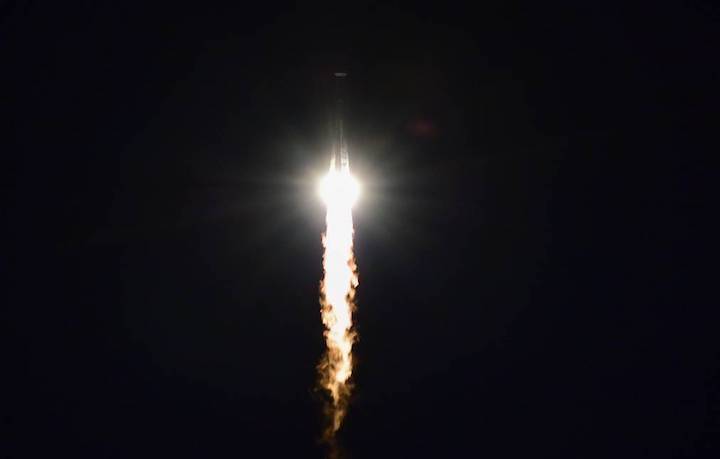
The launch of a Soyuz-ST-B carrier rocket with two Galileo FOC satellites is scheduled for 03:31 Moscow time on December 2, the press service of Russia’s state-run space corporation Roscosmos said.
"In accordance with the launch schedule, approved by Roscosmos, the launch of a Soyuz-ST-B carrier rocket with the Fregat booster and two Galileo FOC satellites is scheduled for 03:31 Moscow time on December 2," the press service said.
The local time of the launch will be 21:31, December 1, the space corporation added.
Earlier, the Soyuz-ST-B carrier rocket with the two satellites was rolled out to a launch pad of the Guiana Space Center (Kourou) in French Guiana.
Quelle: TASS
----
Update: 1.12.2021
.
Galileo satellites given green light for launch
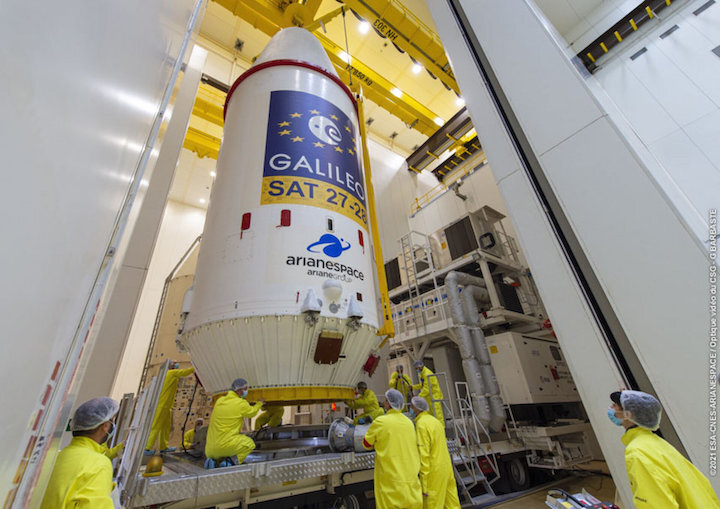
Europe’s next pair of Galileo satellites have been given a green light for launch. Last Friday’s Launch Readiness Review confirmed that the satellites, the supporting ground installations, and the early operations facilities and teams are ready for lift-off on the early hours of Thursday morning, European time.

Galileo satellites 27 – 28 are scheduled to be launched by a Soyuz launcher from Europe’s Spaceport in French Guiana on 2 December at 01:31 CET (1 December at 21:31:27 local Kourou time). Follow the launch live on ESA Web TV Two from 0104 CET.
“Friday’s Launch Readiness Review confirmed that the first two satellites in this final batch of 12 Galileo first generation satellites, are good to go – provided no external circumstances come up between now and the night of 1-2 December,” says Bastiaan Willemse, ESA's Galileo Satellite Manager, from Europe’s Spaceport in Kourou, French Guiana. “And meanwhile the preparation for the launch campaign of the next two satellites has already started.”
The Launch Readiness Review is an ESA-led review with participation of the satellite manufacturer OHB, the launch service provider Arianespace, the Galileo operator SpaceOpal, the EU Space Programme Agency (EUSPA) and the European Commission, as well as the programme’s Security Accreditation Board.
This was the last review before the Arianespace-led RAL (Revue d’Aptitude de Lancement) will takes place next week whereby the latest status of the launcher, the launch facilities and site, the global launch tracking facilities as well the satellites and its supporting ground infrastructure will be reviewed, resulting in the approval for the launch countdown.

The satellites arrived in French Guiana in early October, kicking off a busy launch campaign, including initial dispenser ‘fit checks’ and the filling with the hydrazine fuel that will be used to manoeuvre them during their 12 years of working life.
These satellites will add to the 26 satellites of the Galileo constellation already in orbit and delivering Initial Services around the globe.
This week’s lift-off will be the 11th Galileo launch in 10 years. Two further launches are planned for next year, to allow Galileo to reach Full Operational Capability in its delivery of services, to be followed by the launches of the rest of the Batch 3 satellites which are currently all undergoing final integration at OHB facilities in Bremen and on-ground verification testing at ESA’s ESTEC Test Centre in the Netherlands.

In parallel to Batch 3’s completion of Galileo First Generation deployment, the new Galileo Second Generation satellites, featuring enhanced navigation signals and capabilities, are already in development with their deployment expected to begin by 2024.
About Galileo
Galileo is currently the world’s most precise satellite navigation system, serving more than two billion users around the globe.
The Full Operational Capability phase of the Galileo programme is managed and funded by the European Union. The European Commission, ESA and EUSPA (the EU Agency for the Space Programme) have signed an agreement by which ESA acts as design authority and system development prime on behalf of the Commission and EUSPA as the exploitation and operation manager of Galileo/EGNOS. “Galileo” is registered as a trademark in the database of the European Union Intellectual Property Office (n° 002742237).

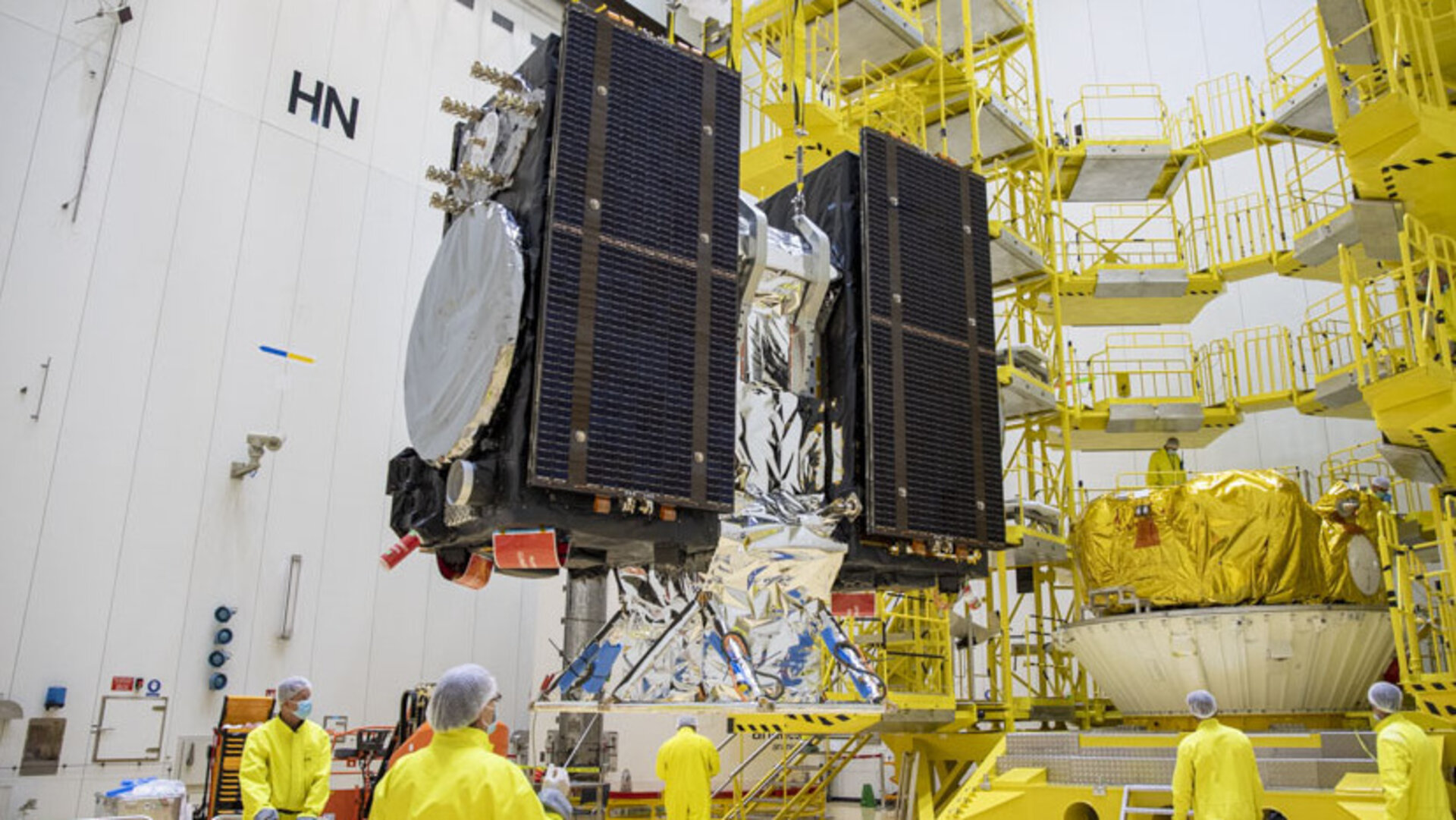
Access the video
Quelle: ESA
+++
Soyuz launch from Kourou postponed due to bad weather — Arianespace
The launch of Russia’s Soyuz-ST-B carrier rocket with two European Galileo navigational satellites was postponed by one day due to bad weather, and will take place early on December 2 (Moscow time), Arianespace CEO Stephane Israel said.
"Due to adverse weather conditions at the Guiana Space Center (CSG), the flight VS26 - initially scheduled for December 1-is being postponed. The Soyuz launch vehicle and spacecraft are in stable and safe conditions," he said in a Twitter post.
According to the official, the launch is now scheduled for 23:27, December 2 local time (03:27 December 3, Moscow time).
Earlier, the Soyuz-ST-B carrier rocket with the two satellites was rolled out to a launch pad of the Guiana Space Center (Kourou) in French Guiana.
Russia’s Soyuz-ST carrier rockets are launched from a pad in the Guiana Space Center as part of an international project bringing together Russia’s state-run space corporation Roscosmos, the European Space Agency, France’s National Centre for Space Studies and a group of leading rocket and space industry enterprises of Russia and France. The first launch took place on October 21, 2011, and 25 Russian rockets have already blasted off from Kourou.
Quelle: TASS
+++
Flight VS26: postponement of the launch
New launch date for Galileo FOC-M9 (23-24), SAT 27-28
Due to adverse weather conditions at the Guiana Space Center (CSG), the flight VS26 –initially scheduled for December 1– is being postponed.
The Soyuz launch vehicle and spacecraft are in stable and safe conditions.
The new earliest targeted launch date is December 2, 2021 at exactly:
> 07:27 p.m. Washington, D.C. time,
> 09:27 p.m. Kourou time,
> 00:27 a.m. Universal time (UTC), on December 3,
> 01:27 a.m. Paris time, on December 3,
> 03:27 a.m. Moscow time, on December 3.
Quelle: ESA
----
Update: 3.12.2021
.
Soyuz launch from Kourou rescheduled due to unreadiness of French telemetry station
The launch of the Soyuz-ST carrier rocket with Galileo navigation satellites from the Kourou spaceport in French Guiana has been rescheduled due to the unreadiness of a French telemetry station, Russia’s Roscosmos state space agency said in a statement on Telegram.
"The launch of the Soyuz-ST-B rocket carrying Galileo spacecraft, which was scheduled to take place at the Guiana Space Center on December 3, has been postponed for 24 hours because of the unreadiness of a French telemetry receiving station," the statement reads. According to Roscosmos, the launch has been rescheduled for 03:23 am Moscow time (00:23 am GMT) on December 4.
Roscosmos Director General Dmitry Rogozin wrote on Telegram earlier that it was the French side that had requested to reschedule the launch.
Head of the French launch service provider Arianespace Stephane Israel said overnight into Wednesday that the launch of the Soyuz-ST-B rocket carrying two satellites for the European Union’s Galileo navigation system had been postponed for a day due to bad weather and would take place early on December 3. Rogozin specified later that there were no technical issues and the launch had been postponed because of winds at high altitudes.
Quelle: TASS
+++
Flight VS26: launch postponed
Due to unavailability of a downrange tracking station, Arianespace has taken the decision to postpone the fueling of the three-stage Soyuz launcher.
Pending the resolution of this anomaly the earliest launch date is now December 3, 2021
- 07:23 p.m. Washington, D.C. time,
- 09:23 p.m. Kourou time,
- 00:23 a.m. Universal time (UTC), on December 4,
- 01:23 a.m. Paris time, on December 4,
- 03:23 a.m. Moscow time, on December 4.
The Soyuz launch vehicle and the satellites are in stable and safe conditions.
Quelle: arianespace
----
Update: 4.12.2021
.
Startabbruch wegen Wetterlage
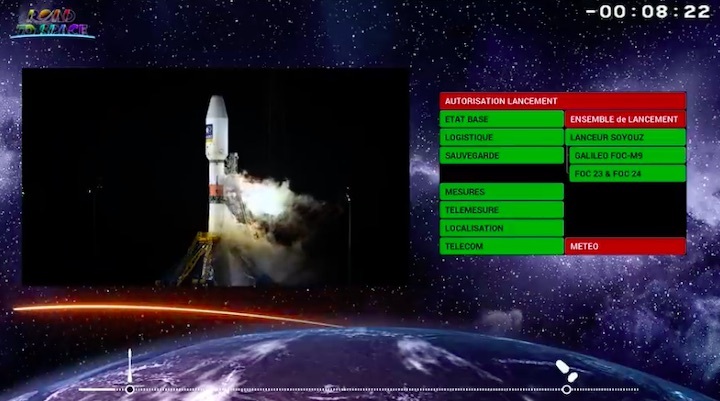
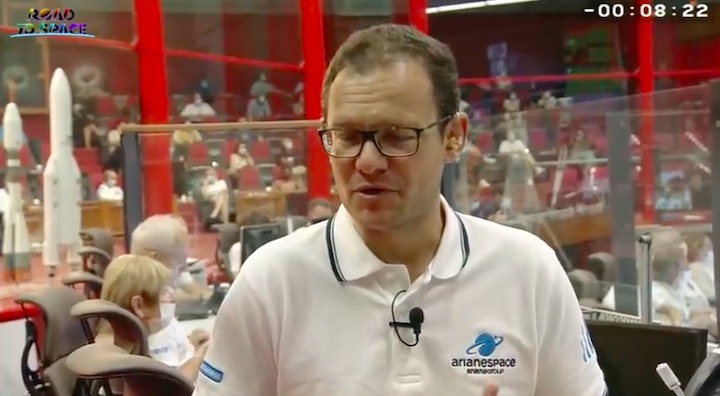
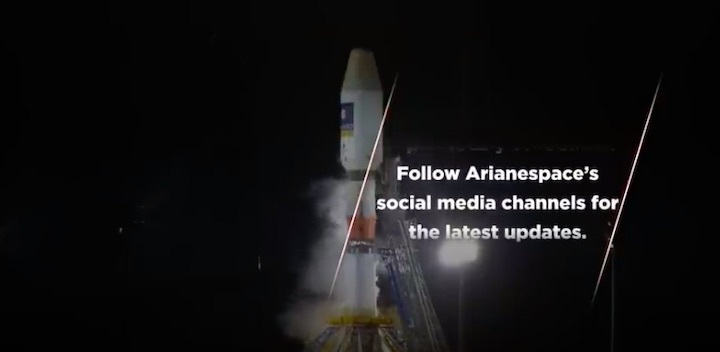
Quelle: arianespace
+++
Update: 5.12.2021
.
Start von ESA VS26 Soyuz Fregat Rakete mit Galileo Satelliten
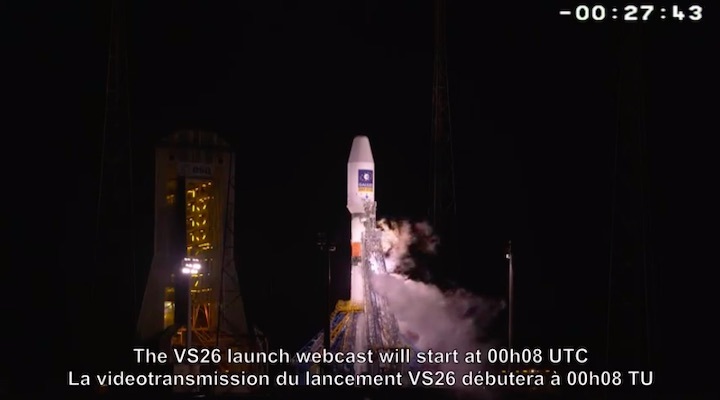
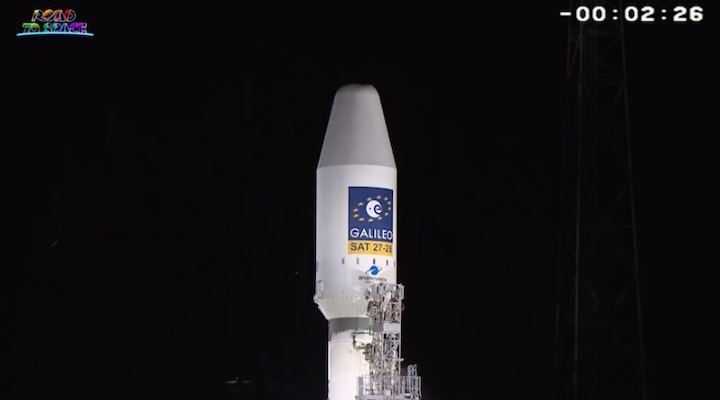
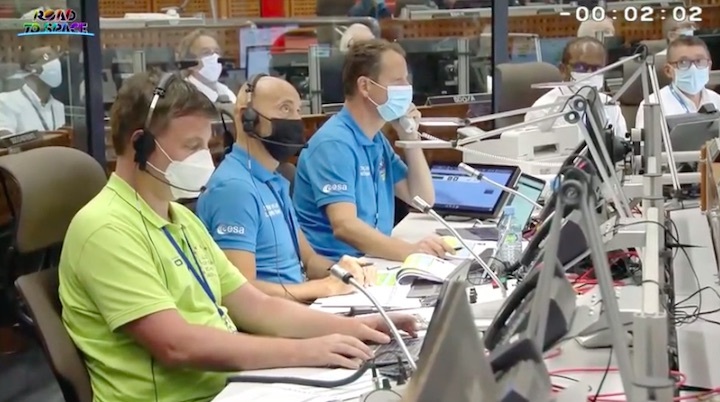
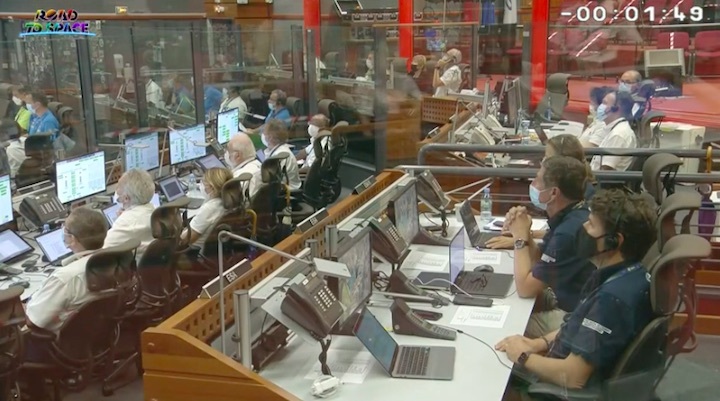
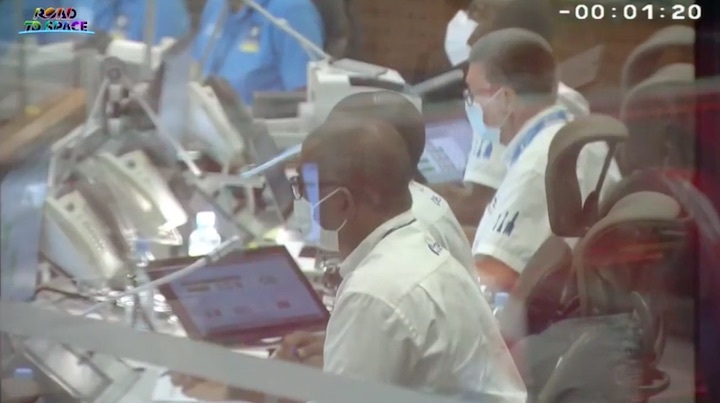
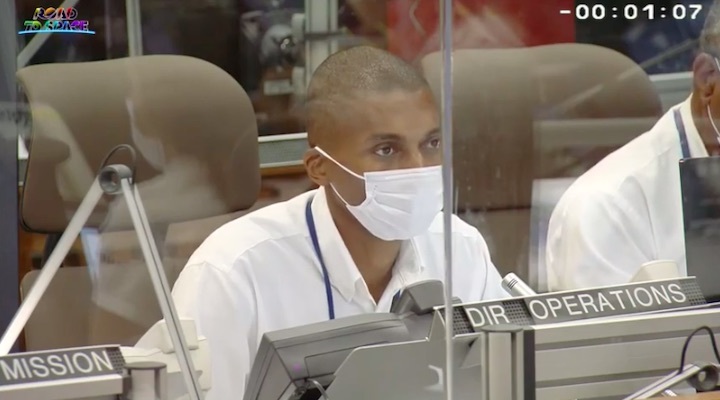
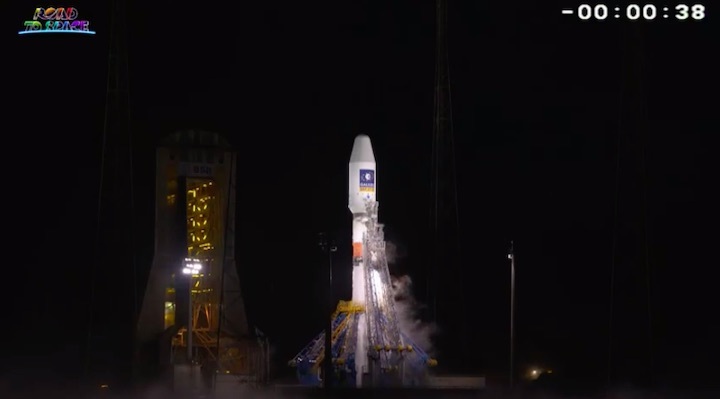
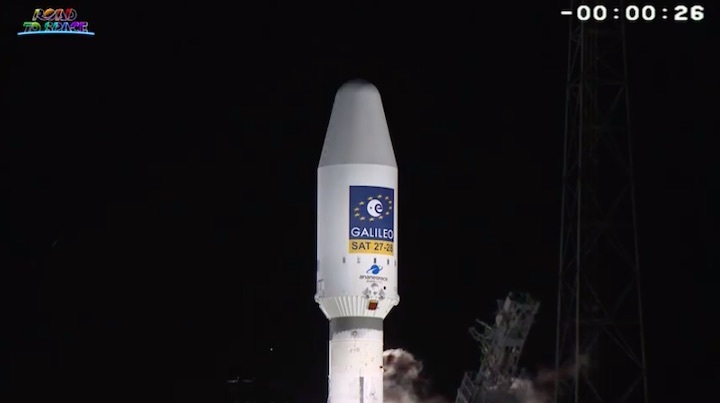
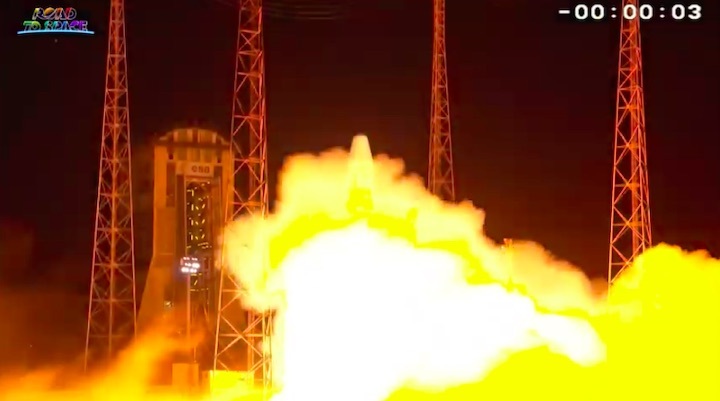
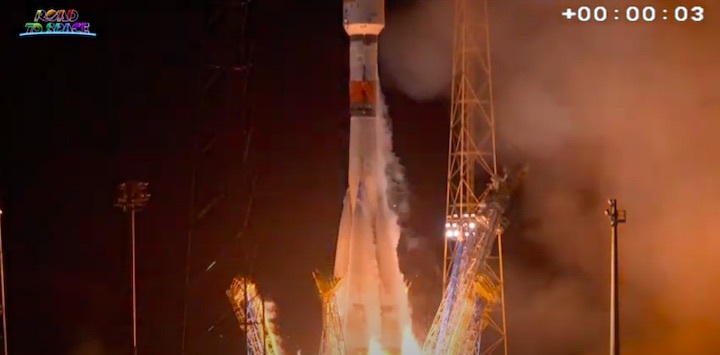
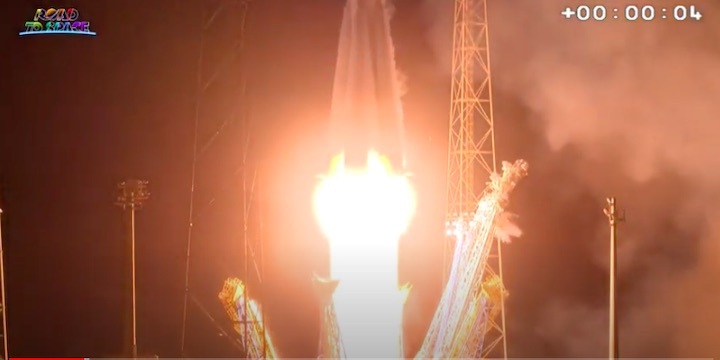
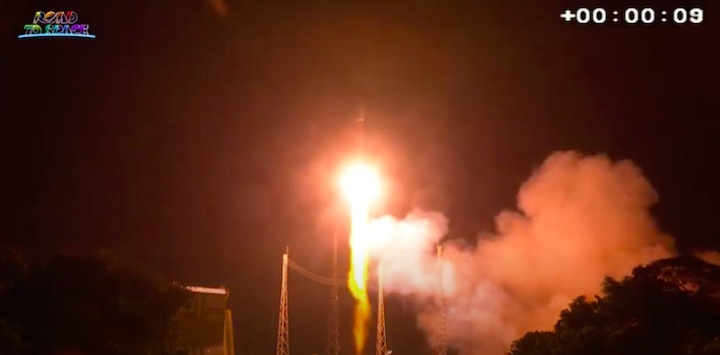
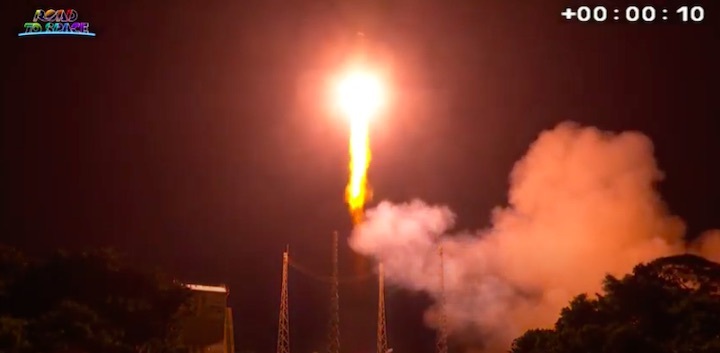
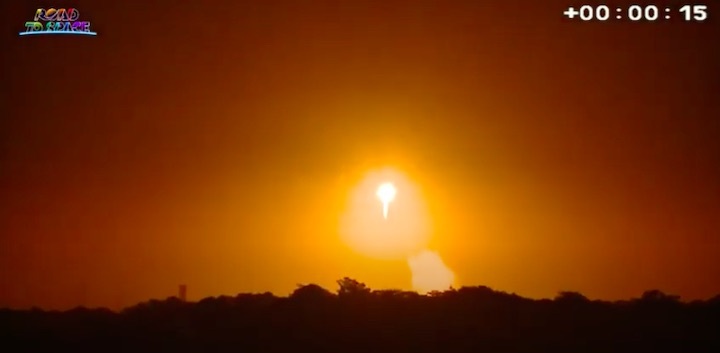
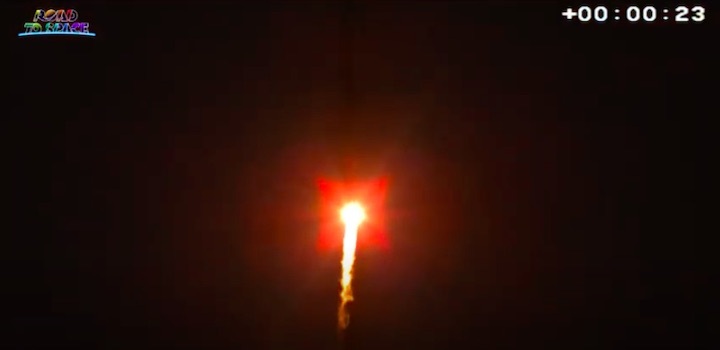
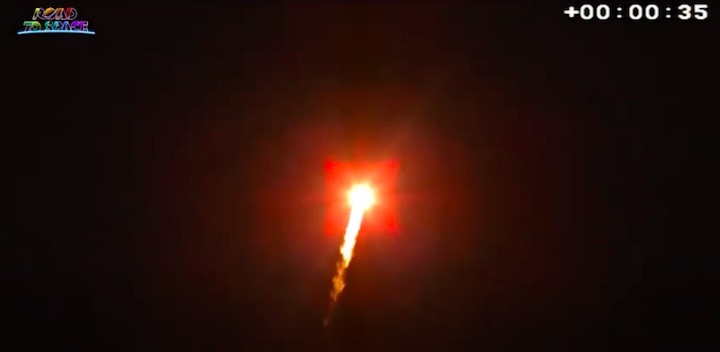
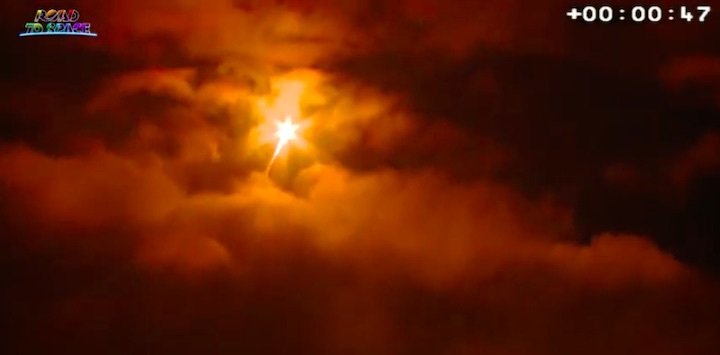
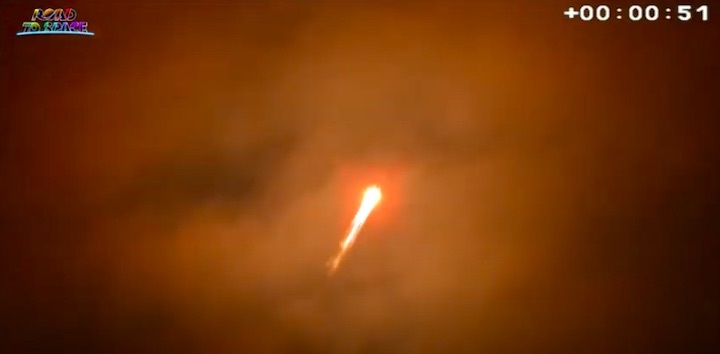
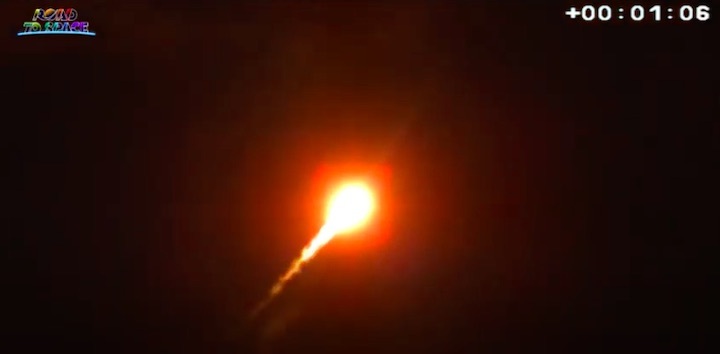
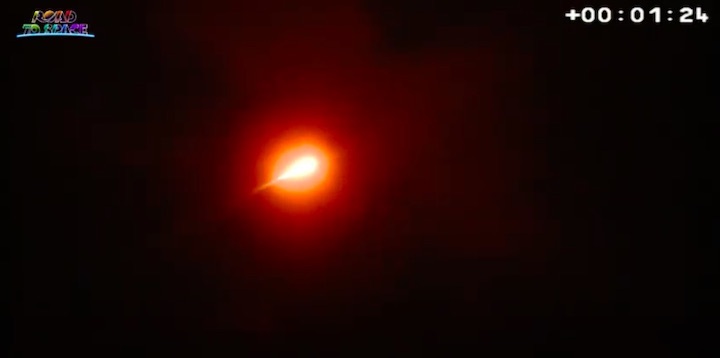
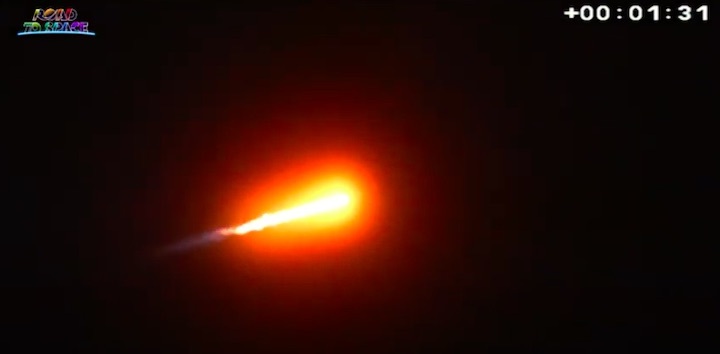
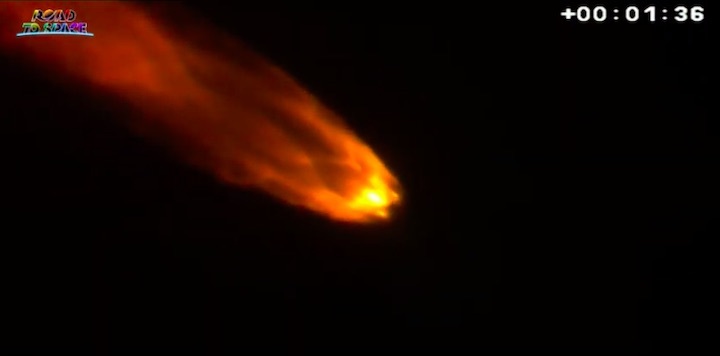
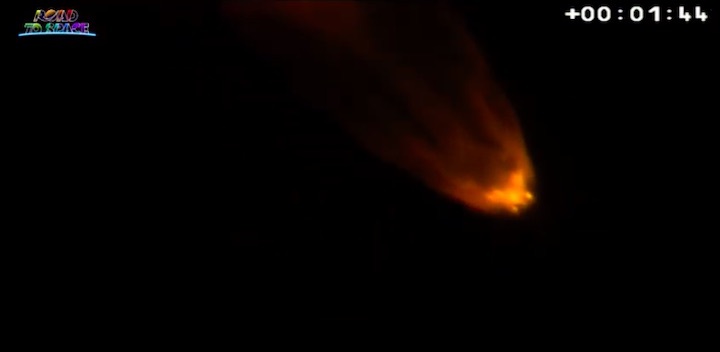
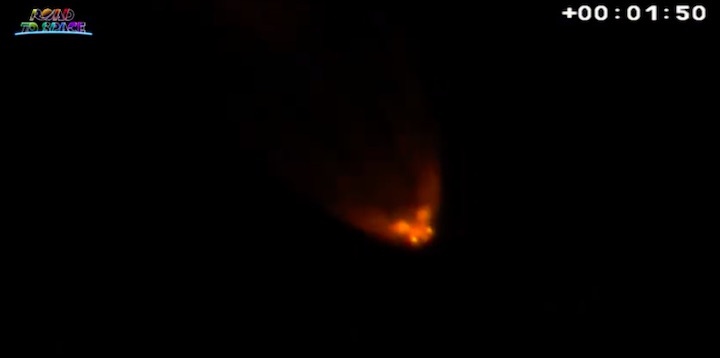
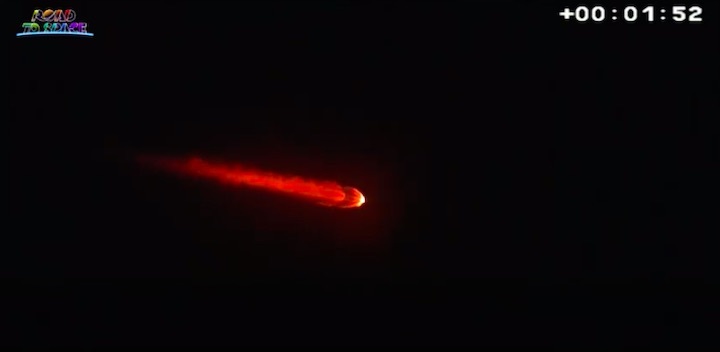
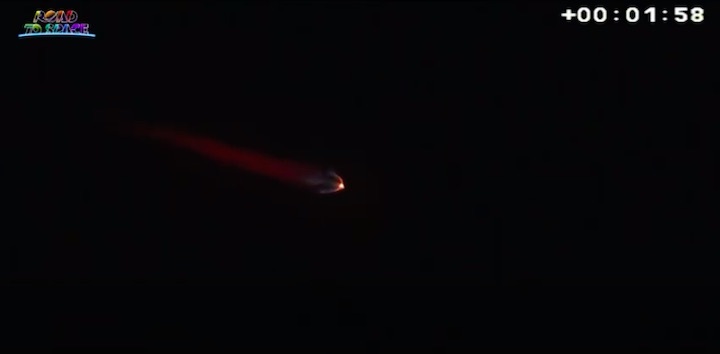
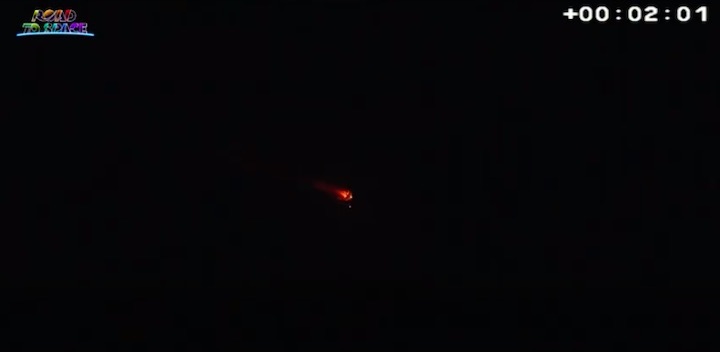
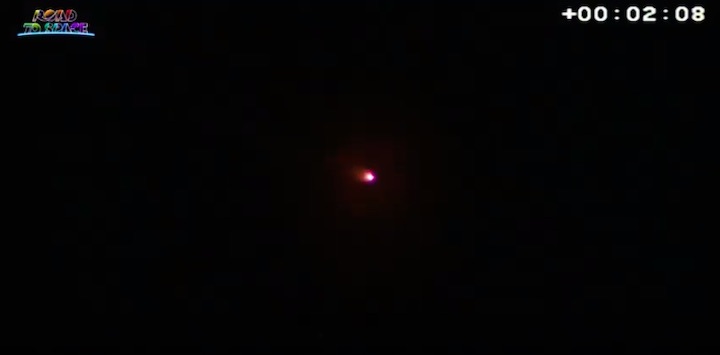
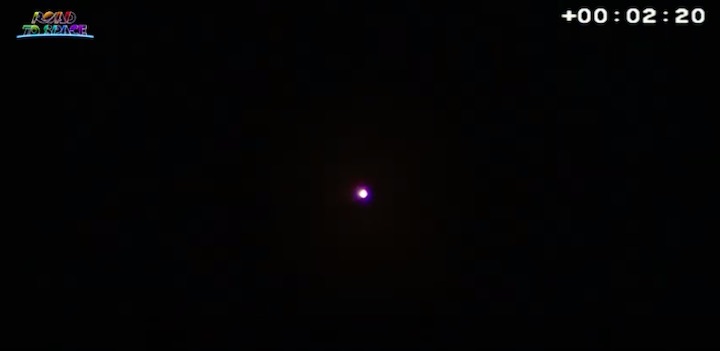
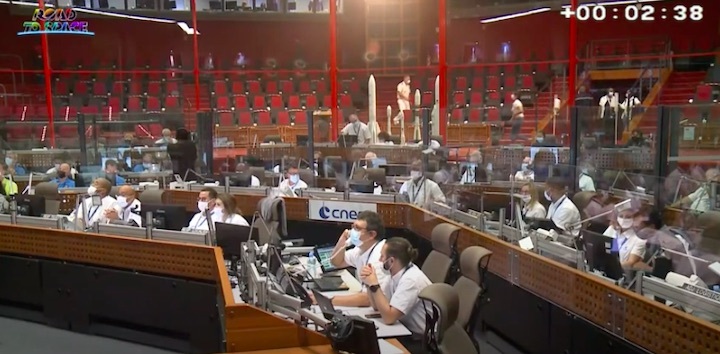
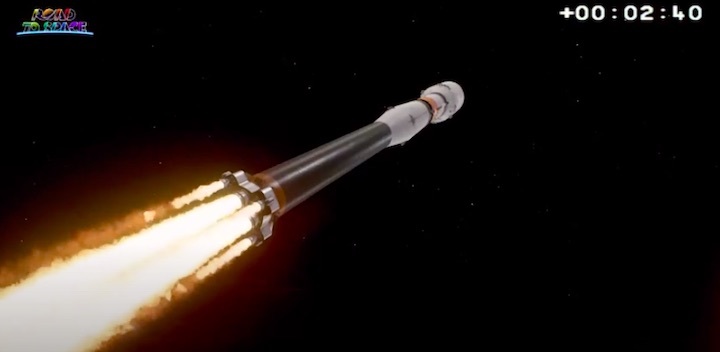
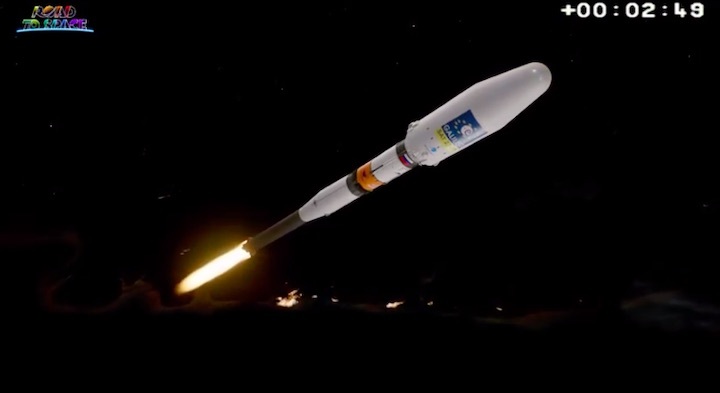
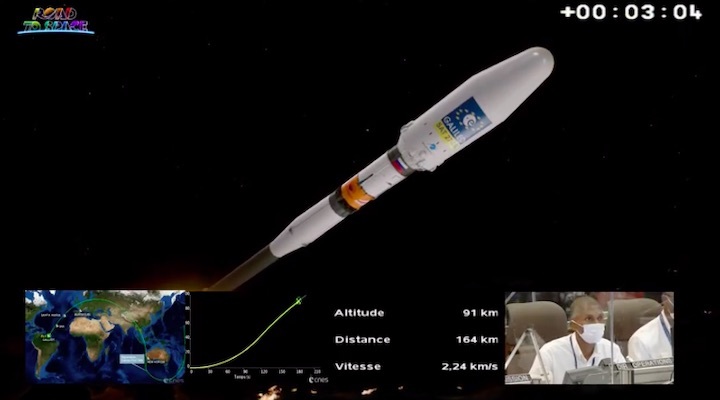
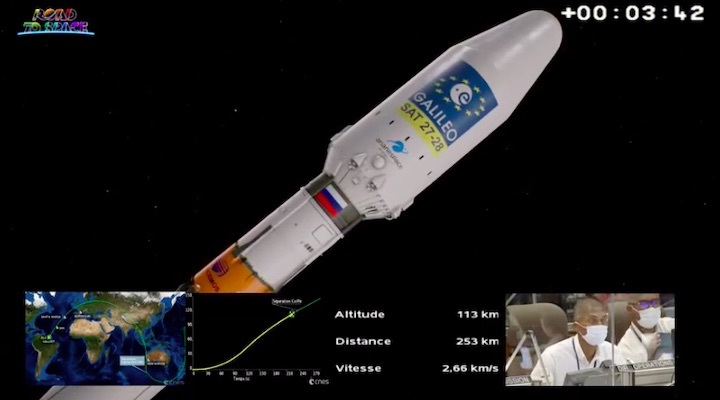
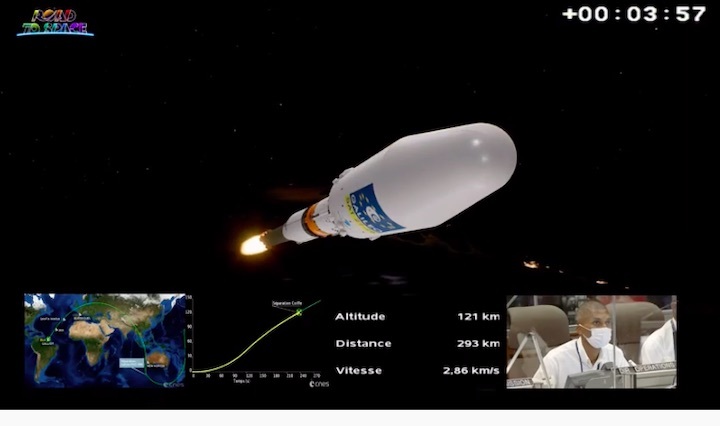
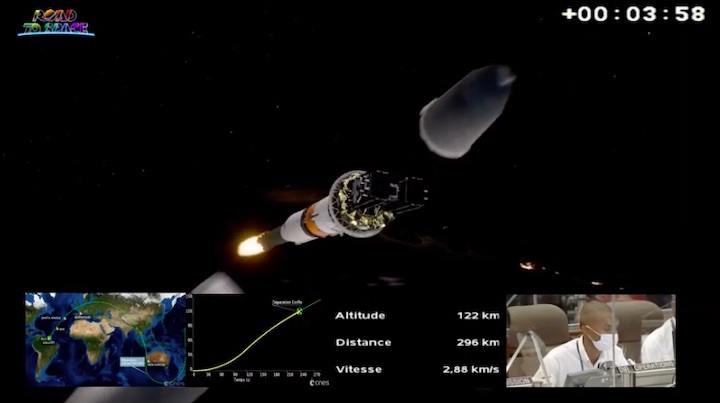
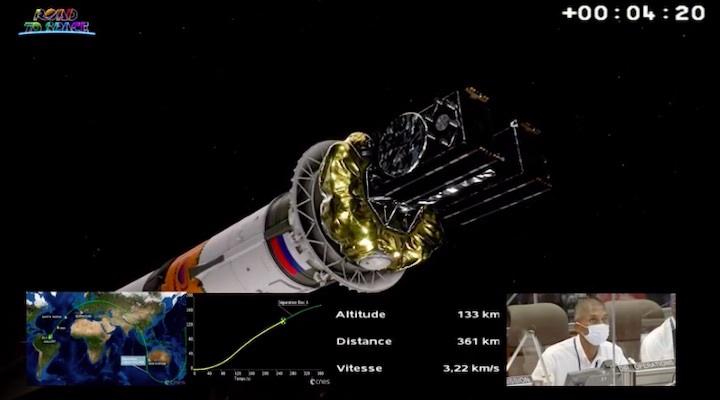
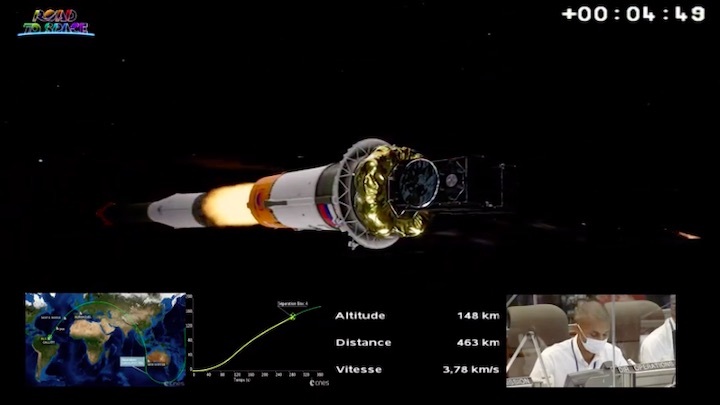
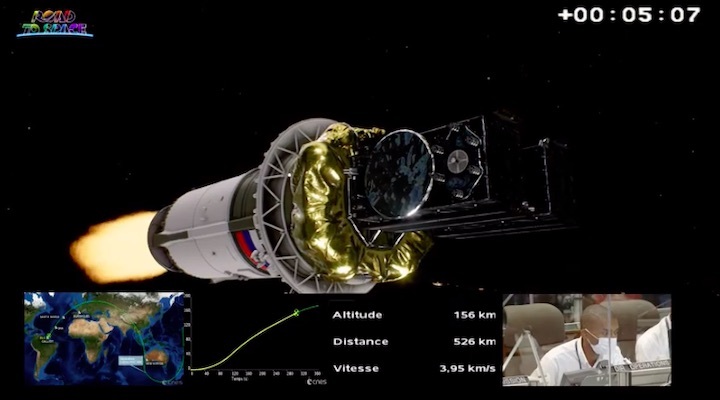
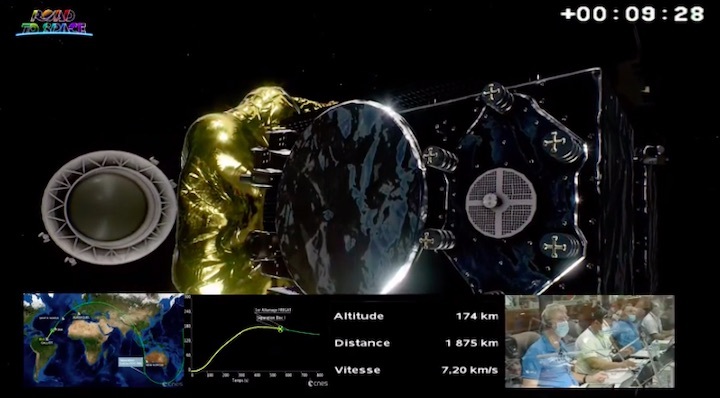
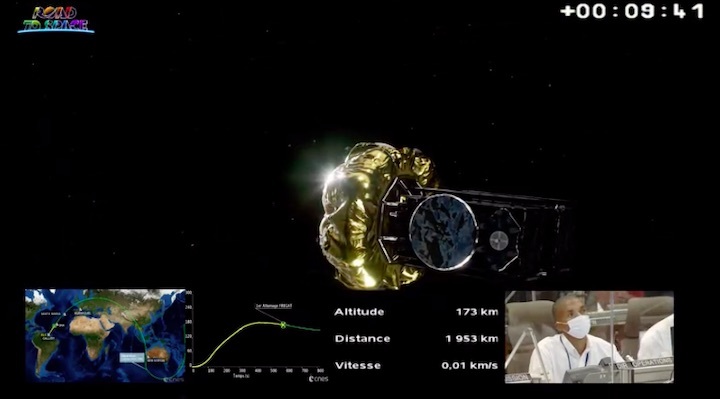
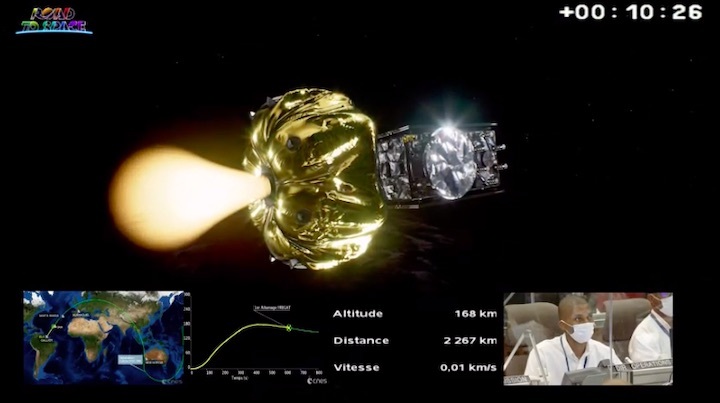
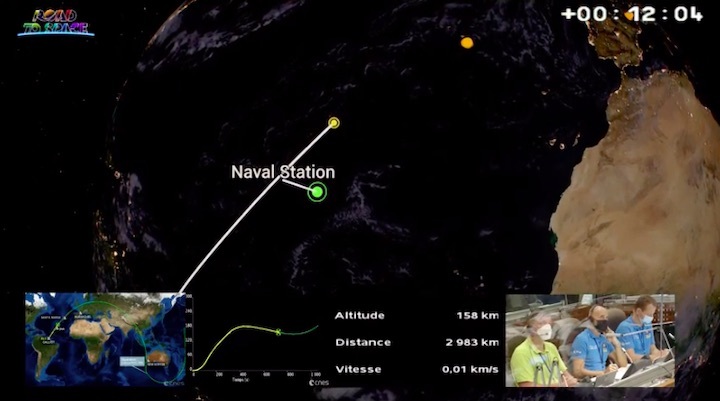
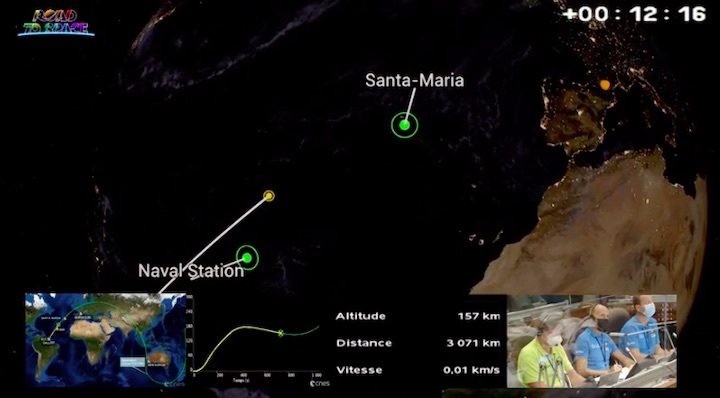
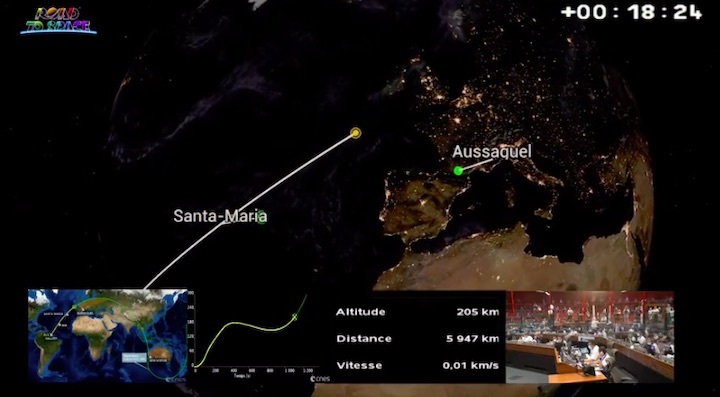
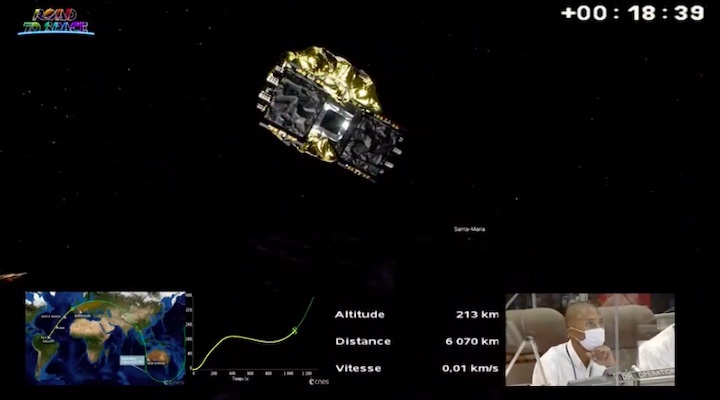
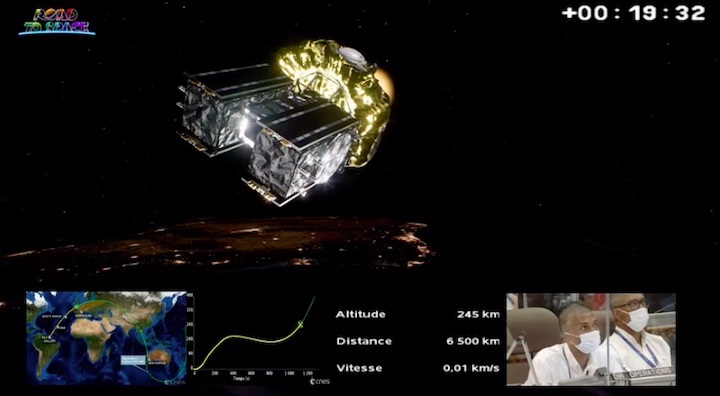
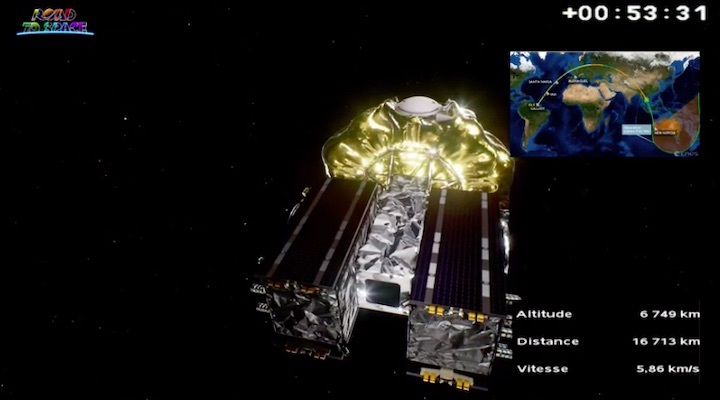
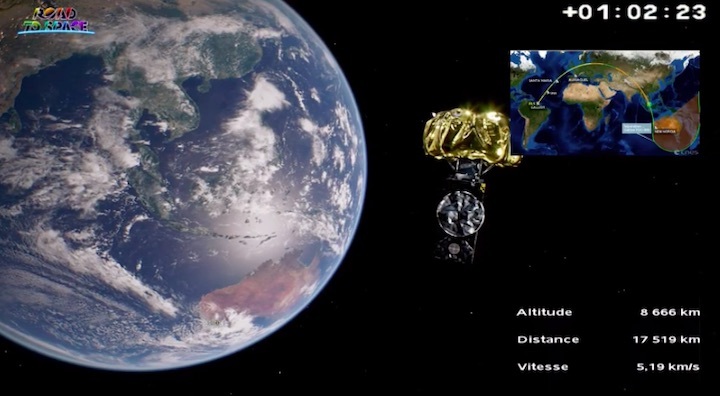
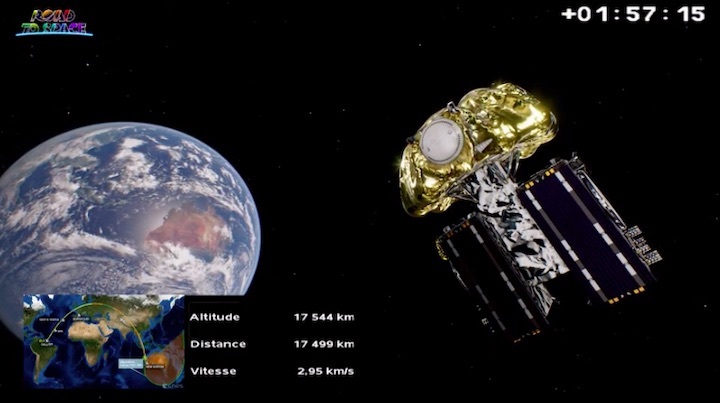
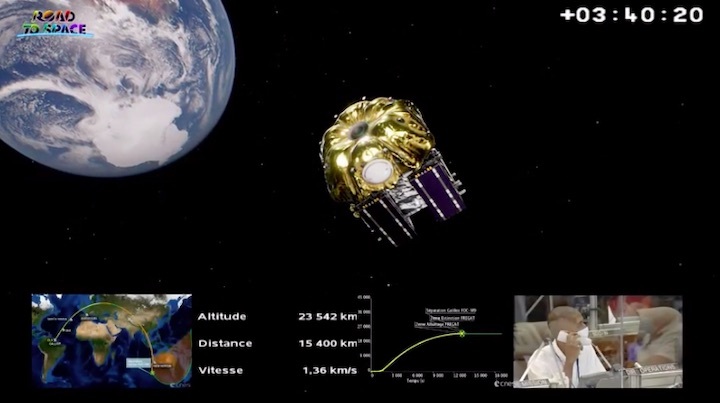
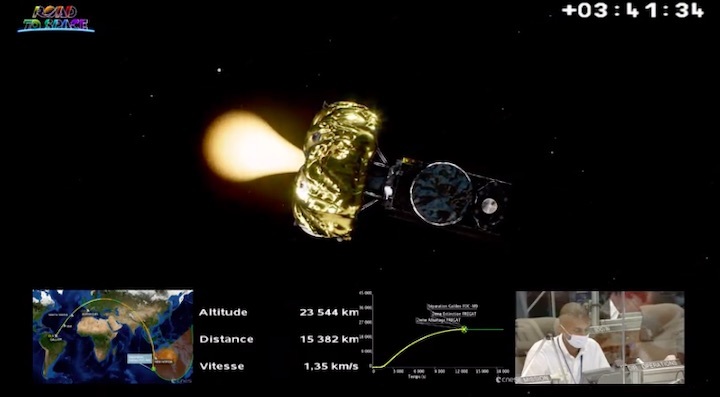
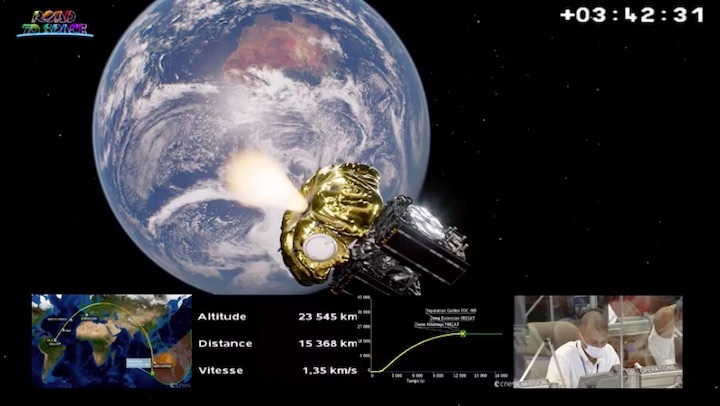
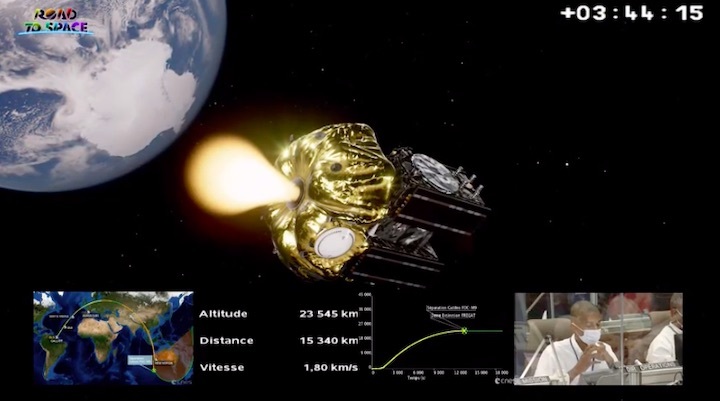
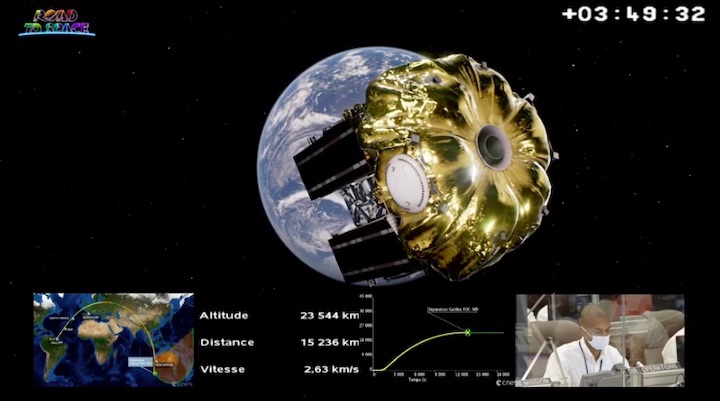
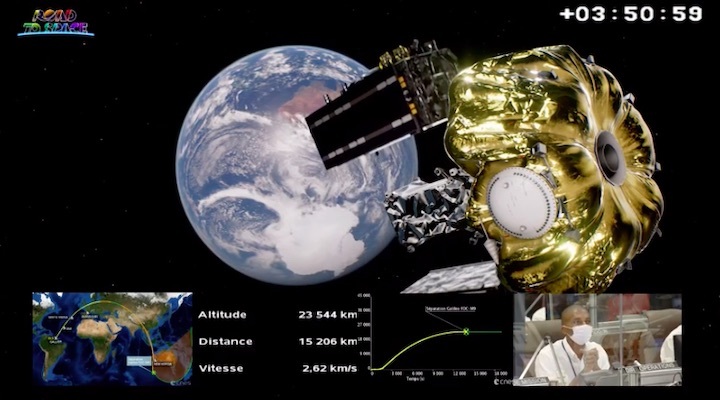
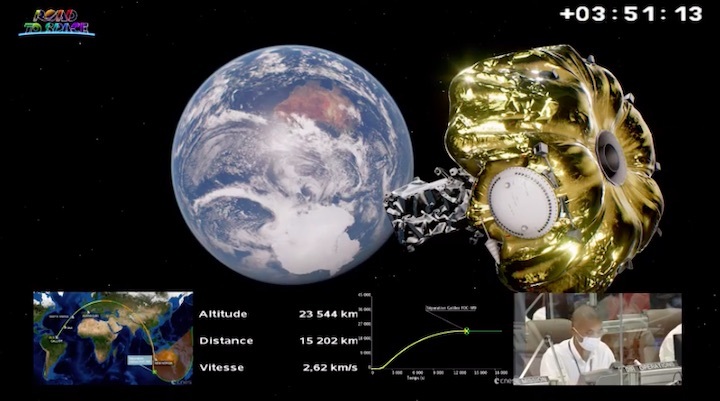
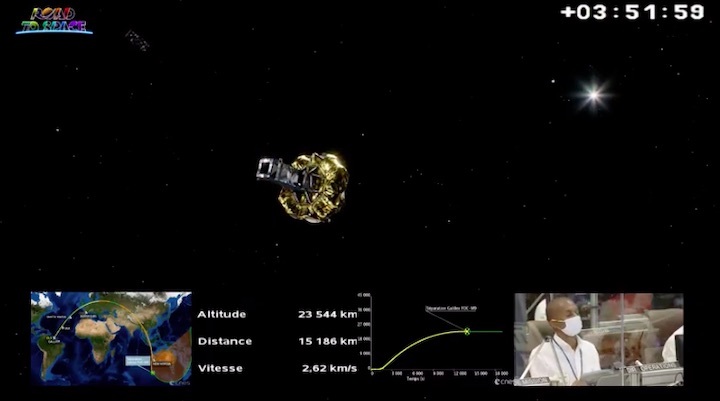
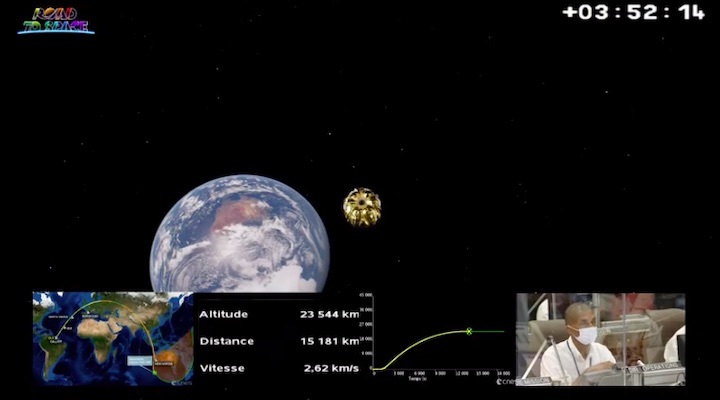
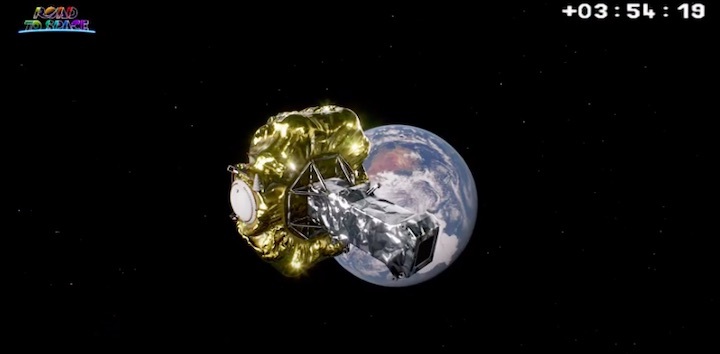
Quelle: arianespace
+++
Soyuz-ST-B with 2 Galileo satellites launched from Kourou spaceport
The Soyuz-ST-B carrier rocket with the Fregat booster and two Galileo FOC satellites was launched from the Guiana Space Center (Kourou) in French Guiana on Saturday. The live broadcast is being held on the website of the Arianespace company.
The rocket is to bring on the orbit two Galileo FOC navigation satellites for the Galileo global navigation satellite system.
The launch was initially scheduled for the night of December 2 but was postponed twice. For the first time it was postponed due to bad weather and for the second time the telemetry station of the Guiana Space Center was not ready.
The Soyuz at GSC is an international space project of the Russian space corporation Roscosmos, the European Space Agency, France’s National Center for Space Studies (CNES) and the leading enterprises of the rocket and space industry in Russia and France. As part of the project, specialists from the Center for Operation of Ground-Based Space Infrastructure Facilities at the GSC built a special launch complex for Soyuz-ST launch vehicles. Since the first launch on October 21, 2011, 25 Soyuz-ST rockets have been launched.
Taking into account the two new vehicles of the Galileo project, a total of 28 satellites (including experimental and working vehicles) will be launched into low-earth orbit. The previous launch took place on July 25, 2018, when an Ariane 5 rocket launched four Galileo FOC satellites.
Quelle: TASS
+++
VS26: Galileo successfully expands his fleet with Arianespace

- On Saturday, December 4, Arianespace has successfully orbited two satellites from the Guiana Space Center (CSG), Europe’s Spaceport in French Guiana. This was the eleventh launch for the constellation by Arianespace, which has now orbited 28 satellites, including 4 IOV, for Galileo.
– With this 13th success of the year, Arianespace hits a new milestone by launching the 179th and 180th satellites for European institutions.
On Saturday, December 4, at 09:19 p.m. local time, a Soyuz launcher lifted off from the CSG in Kourou, French Guiana, and successfully orbited two satellites built by OHB System: Galileo FOC-M9 (23-24), SAT 27-28, as a part of Europe’s Galileo constellation.
These two satellites are the 179th and 180th launched on behalf of European institutions. More precisely, it is the 61st mission launched by Arianespace for ESA and the 23rd and 24th FOC satellites launched by Arianespace for the European Commission.
“Congratulations Europe! With this 11th launch for Galileo, the constellation is now counting 28 satellites in orbit. Arianespace is proud to guarantee a secure and autonomous access to space with the deployment of Galileo, marking another step towards European independence in satellite navigation,” said Stéphane Israël, CEO of Arianespace. “I would like to thank the European Union, especially the European Commission, as well as the European Space Agency, our direct customer for this launch, for continuing to trust us with their satellites.”
Operational since 2016, Galileo is the global navigation satellite system that is fully financed and owned by the European Union. Under civilian control, it offers high-precision positioning, navigation and timing services to more than 2,3 billion users worldwide. Undertaken by a European partnership, the European Commission manages Galileo, with European Space Agency (ESA) as the design authority overseeing its development, procuring satellites and the ground segment, and the European Union Agency for the Space Programme (EUSPA) overseeing Galileo operations and service provision.
The medium-lift Soyuz (produced by Progress Space Rocket Center, part of the Russian space agency Roscosmos) entered service from Europe’s Spaceport in French Guiana in October 2011, bringing the industry’s longest-operating launcher to the world’s most modern launch base. Soyuz is a four-stage launcher, designed with extremely high reliability requirements for its use in manned missions. This flight will also mark 10 years of Soyuz operations in French Guiana and its 26th mission for the European Spaceport.
VS26 figures:
- 337th launch overall for the Arianespace family of launchers (301st launch of the family at CSG),
- Galileo FOC-M9 are the 1063rd and 1064th satellites launched by Arianespace,
- Galileo FOC-M9 are the 490th and 491st satellites launched on Soyuz by Arianespace (66th and 67th at CSG).
Quelle: arianespace
